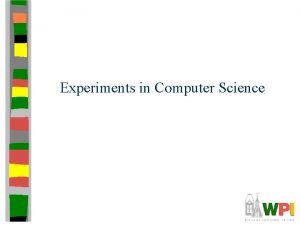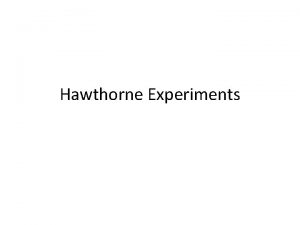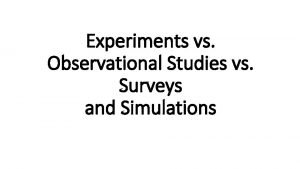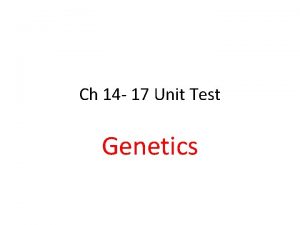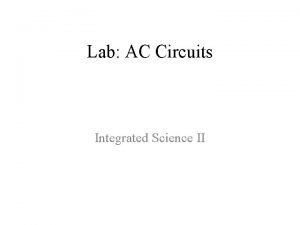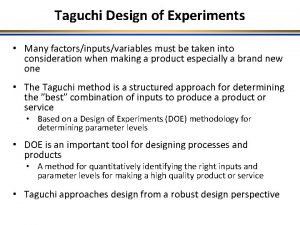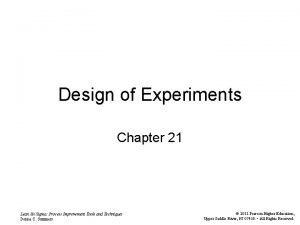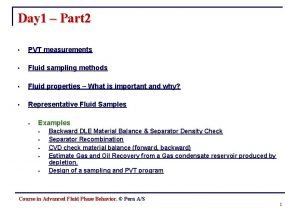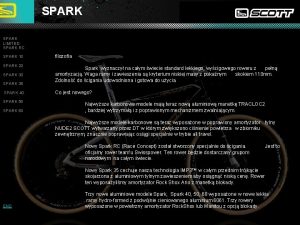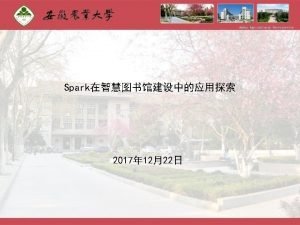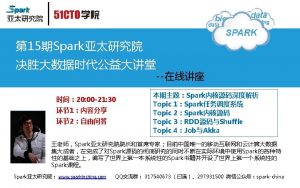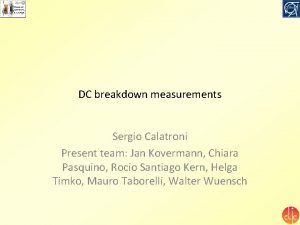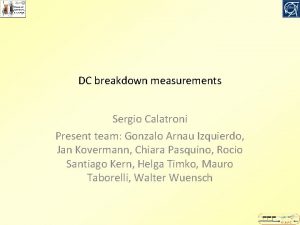DC Spark Experiments Nick Shipman Sergio Calatroni Tomoko



































- Slides: 35

DC Spark Experiments Nick Shipman, Sergio Calatroni, Tomoko Muranaka, Walter Wuensch - CERN Roger M. Jones - Manchester 16/09/2020

Why study breakdown in a DC System for CLIC RF tests are expensive and time consuming. DC tests allow many more tests to be carried out. The physics in DC tests is also simpler, no pulse surface heating, pre-breakdown magnetic fields etc. In order to understand the physics of RF breakdown, DC breakdown must be understood first! For example it would never have been practically possible to get this lovely plot using only RF tests. 2

What are the CERN DC spark systems? There are two systems which consist of an anode and cathode in a rod-plane geometry in ultrahigh vacuum. The gap size can be varied but is typically 20 um. The diameter of the anode is 2. 3 mm and has a rounded tip. A high voltage can be applied to the tip using a mechanical relay. By applying lower voltages and using a sensitive electrometer field emission currents can also be measured. These measurements enable us to calculate Beta. 3

Three limitations of the spark systems 1. Low repetition rate 2. Only a small area of the cathode is exposed to high fields. 3. Slow, contact, measurement of the electrode gap 4

The High Repetition Rate (HRR) System 5

Motivation behind the HRR system • CLIC is interested in the low breakdown regime ~10^-7 BDs/pulse/m. • With the mechanical relay the maximum operating frequency is only 0. 5 Hz. • 10^7/0. 5 Hz ~ 7. 7 months • By using a solid state switch the HRR system can operate at 1 k. Hz • 10^7/10^3 Hz ~ 3 hours We should also be able to test the BDR vs. E scaling theory proposed by Flyura Djurabekova. 6

The High Rep Rate System The picture below shows the HRR system. The metal box housing the switch is placed as close as possible to the vacuum chamber to minimise stray capacitance. The solid state switch used is the Behlke 181 25 -B, which can operate at 1. 8 k. Hz handle an open voltage of 18 k. V and a peak current of 250 Amps. 7

The High Repetition Rate System Key Features • Repetition rates of up to 1 k. Hz • Voltages up to 12 k. V (20 um gap 600 MV/m) • High Bandwidth <= 10 ns • Uses solid state switch • Coaxial cables, and matched impedances used throughout • Energy is stored on a 200 m long spool of coaxial cable, the “Pulse Forming Line” or PFL. • Replaces old 0. 5 Hz mechanical relay. 8

The High Rep Rate System The circuit diagram of the HRR system. It can be thought of as consisting of three parts: the charging section; the energy storage section; and the power delivery section. 9

The High Rep Rate System PSpice simulation of the HRR circuit during a breakdown. The switch is closed at 1 us and the breakdown occurs at 2 us. Measured voltage and current signals in the HRR circuit during a breakdown. The switch is closed at 1 us and the breakdown occurs at 2 us. 10

The High Rep Rate System 11

The Fixed Gap System 12

Motivation behind the fixed gap system This fixed gap system solves two key issues… 1. There is no need to measure the electrode gap, it is fixed. 2. The surface area is very much larger, so hopefully breakdown will usually occur on “virgin” surface which hasn’t seen a breakdown yet. Also the system is very compact 30 cm x 30 cm. This will allow the whole system to be placed inside a 2 T magnet we have here at CERN, enabling us to study the effect an external magnetic field has on the BDR. (Both perpendicular and parallel). These SEM pictures well illustrate the difference in experimental conditions in RF tests (Right) which even after 100 s of hours of testing shows minimal surface modification compared to just 5 breakdowns in the present DC spark system (Left). 13

The Fixed Gap System Despite the comparatively large size of the anodes, the system is very compact. Four antennas are included in the design to pick up the radiation from breakdowns. The surface of the electrodes are 80 mm in diameter and have a surface tolerance of <1 um. The picture on the right 14 shows the high precision turning.

The Fixed Gap System Key Features • Uses disc shaped electrodes with a large active surface area ~50 cm^2 • Gap size is fixed eliminating the need for measurement. • Gap size accurate to less than 1 um across entire surface, even under large E-field stress (total forces of up to 500 kg). • 4 pick up antenna and 4 viewports • Very compact, diameter ~30 cm height ~30 cm. • Electrodes are interchangeable. • Ceramic spacer is interchangeable allowing different gap sizes to be selected. 15

Non-contact gap measurement 16

Motivation behind the non-contact gap measurement For the “old” DC spark systems, a non-contact capacitive method has been developed to measure the electrode gap. • This will avoid the need to touch the cathode avoiding any potential damage to delicate surface features which we may be interested in investigating. • It will be automatic so it will also allow the gap to be measured more often and adjusted during an experiment if needed. A SEM image shows jagged damage to the cathode. This must have been formed after the smoothed craters caused by breakdown, maybe by the contact gap measurement. 17

Non-contact gap measurement Key Features • For use with the tip and plane geometries of System 1 and 2, not needed for fixed gap system. Anode Gap Cathode • Measures the absolute distance between the electrodes without them coming into contact. • Relies on the accurate measurement of the very small capacitance between electrodes. • A computer controlled stepper motor allows the measurement to be made automatically. • Has been tested successfully in air and is now been expertly installed in system II by Tomoko. 18

Results so far… BDR vs. E 19

The global surface field at 3. 4 k. V is 170 MV/m with a gap size of 20 um.

Distribution Analysis Steep vertical parts are indicative of clusters. The distribution between BDs obeys the Poisson law but only when clusters have been removed

Results so far… Measured Turn on Times 22

Firstly - why are we interested in turn on time? RF tests indicate that low group velocity, and consequently narrow bandwidth structures are able to sustain much higher surface fields than high group velocity, large bandwidth, structures. Further study has led to the idea that the process which governs the turn on time is the instantaneous power flow available to feed the breakdown during its onset. In other words a high group velocity structure could more quickly replenish local energy density absorbed by a growing breakdown leading to faster turn on times. An accurate measure of the rise time of breakdowns in the DC systems under electrostatic conditions is an essential precursor to understanding whether the transient response of RF systems to the breakdown currents determine breakdown limits. For more background see references below [1] C. Adolphsen 2005, “Advances in Normal Conducting Accelerator Technology from the X-Band Linear Collider Program”, PAC 2005 pp. 204 -8. [2] A. Grudiev, S. Calatroni and W. Wuensch 2009, “New local field quantity describing the high gradient limit of accelerating structures”, PRSTAB, vol. 12, no. 10, pp. 102001 -1 -102001 -9. 23

Secondly how we define the “Turn on time” • What we measure: • DC - voltage fall time • RF - transmitted power fall time Slide courtesy of Alexey Dubrovskiy

DC Spark System Turn on Time Sample size = 50 The spread in voltage fall times (and current rise times) is extremely small compared to the RF case. The measured current rise time always shorter than voltage fall time due to initial charging current overlap. 25

The power supply was always set at 4 k. V. However a breakdown often occurred before the voltage across the gap had reached this value. The higher the gap voltage immediately before breakdown the longer the slope. I had not expected to see any correlation as I expected the tiny variation in breakdown times to be dominated by noise or error. 26

Where breakdowns occur very early the voltage across the gap is still charging up resulting in an increase in fall time. Once the voltage across the gap is fully charged there is no discernible difference in the voltage fall time. 27

The Swiss FEL turn on times are much longer than in the DC case and the variation is much greater, this is keeping with other RF breakdown turn on time measurements. 28

Summary of turn on times Test Frequency Measurement Simulation Result 0. 25 ns New DC System DC Voltage Fall Time 12 -13 ns Swiss FEL (CBand) 5. 7 GHz Transmitted Power Fall Time 110 - 140 ns KEK T 24 (X-Band) 12 GHz Transmitted Power Fall Time 20 -40 ns CTF/TBTS TD 24 (X-Band) 12 GHz Transmitted Power Fall Time 20 -40 ns CTF SICA (SBand) 3 GHz Transmitted Power 60 -140 ns The turn on time does not seem to be related to the bandwidth of the structures but to the frequency or possibly the intrinsic size. 29

Results so far… Measured Burning Voltages 30

Measured Burning Voltages The burning voltage was measured across here. It is the “steady state” voltage across the plasma of a spark during a breakdown at which point most of the voltage is dropped across the 50 Ohm resistor. It is a property of the material. Subtract average voltage with switch closed from Average voltage during breakdown after initial voltage fall. 31

Measured Burning Voltages The literature gives a value for the burning voltage of clean copper of ~23 V. This is lower than what I have measure so far in the DC spark system. But I have not measured or corrected for the short circuit resistance of cables etc. 32

Burning Voltages • Depending on when the breakdown occurs there is sometimes a paucity of data points with which to make the average needed to acquire the burning voltage value. • It is these cases which are responsible for the higher values of burning voltages seen on the histogram. • This may suggest that the plasma burning voltage starts high and then settles to a lower value later. This will be investigated further. • The nature of the oscillations will also be investigated further, they could either be due to an LC type ringing in the powering system or due to plasma oscillations in the Arc. 33

Future Plans 34

Future Plans • Further BDR vs. E measurements at lower BDR. • Investigate effect of an external magnetic field on the BDR with the fixed gap system. • Investigate the effect of gap size on the turn on time with the fixed gap system. 35
 Nick shipman
Nick shipman Tomoko makishima
Tomoko makishima Tomoko uemura in her bath
Tomoko uemura in her bath Spark sql: relational data processing in spark
Spark sql: relational data processing in spark Shipman's 4 key questions
Shipman's 4 key questions Margaret floy washburn approach to psychology
Margaret floy washburn approach to psychology Computer science experiments
Computer science experiments Design of experiments doe
Design of experiments doe Tom campbell virtual reality
Tom campbell virtual reality M&m experiments with scientific method
M&m experiments with scientific method How do scientist test hypothesis? *
How do scientist test hypothesis? * Split brain experiments
Split brain experiments Design of experiments presentation
Design of experiments presentation Dream experiments
Dream experiments Relay room experiment
Relay room experiment Experiments in goodness
Experiments in goodness What are surveys experiments or observation
What are surveys experiments or observation What is radial conduction
What is radial conduction Checklist for good practices in laboratory experiments
Checklist for good practices in laboratory experiments A balanced outlook on law
A balanced outlook on law Observational study vs experiment
Observational study vs experiment 2k factorial experiments and fractions
2k factorial experiments and fractions Twins nature vs nurture
Twins nature vs nurture Design of experiments
Design of experiments Czech experiments
Czech experiments In his transformation experiments what did griffith observe
In his transformation experiments what did griffith observe Investigating conductors lab report
Investigating conductors lab report Observational study vs experiment worksheet
Observational study vs experiment worksheet Taguchi design of experiments
Taguchi design of experiments Design of experiments six sigma
Design of experiments six sigma Colorimetry involve
Colorimetry involve Examples of binomial experiments
Examples of binomial experiments Mendels three laws of inheritance
Mendels three laws of inheritance Science risk assessment primary school
Science risk assessment primary school Science experiments for highschool
Science experiments for highschool Pvt experiments
Pvt experiments






